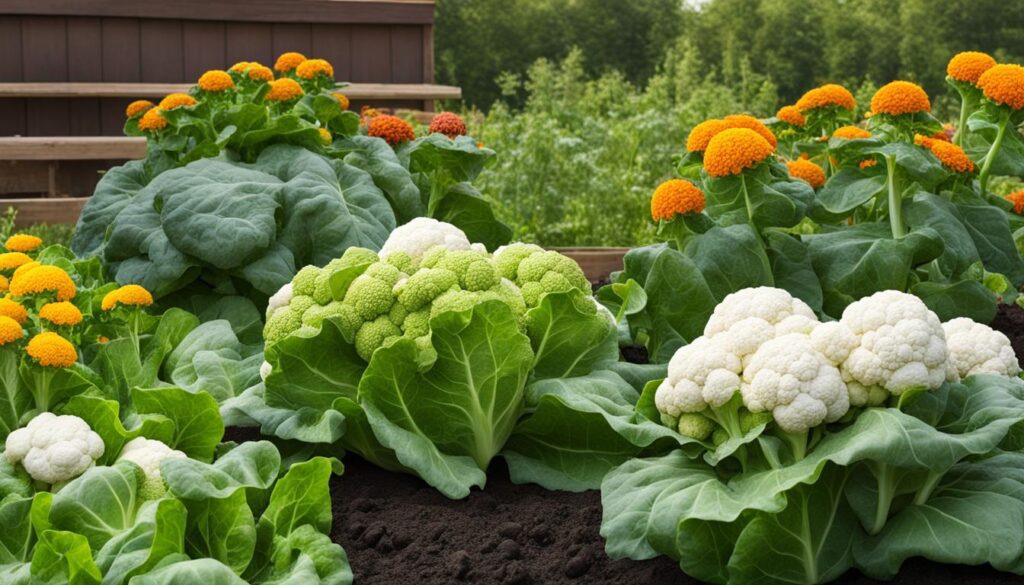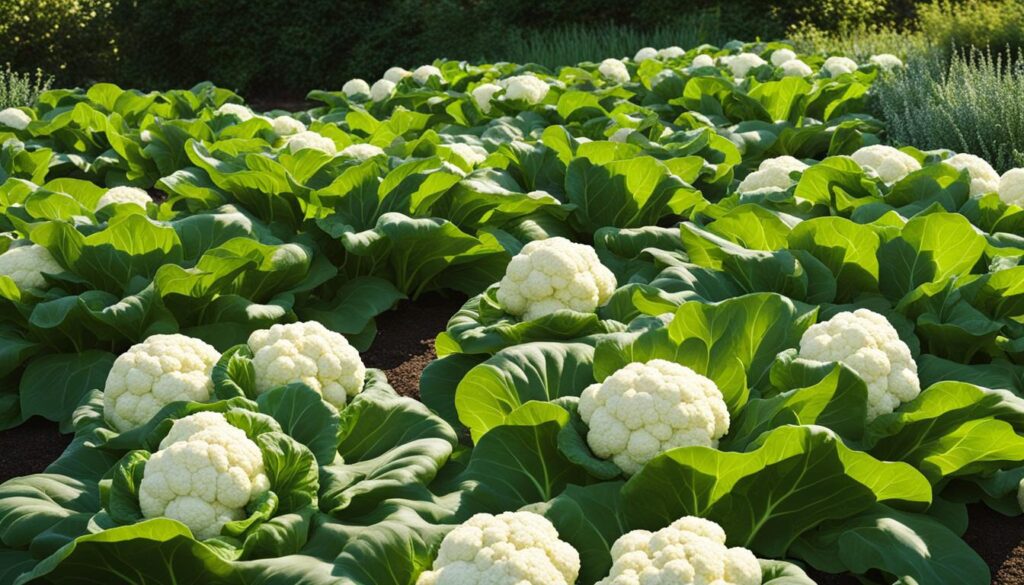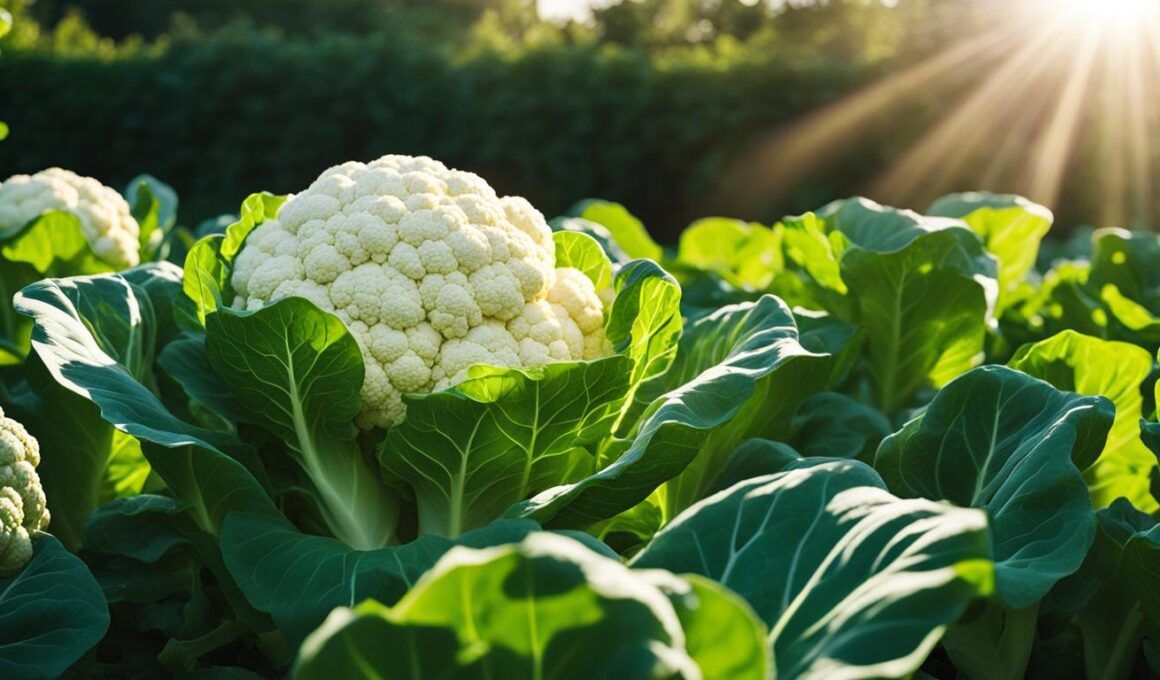Growing cauliflower and spinach together in your garden is a great way to maximize your harvest and enjoy fresh produce at home. Companion planting is a gardening technique where you plant two or more different types of plants together to help them grow better. Cauliflower and spinach make great companions as they provide shade to the soil, retain moisture, and protect each other from pests and diseases. Additionally, they provide each other with essential nutrients needed for growth.
Post Summary:- Companion planting involves planting different types of plants together to enhance their growth.
- Cauliflower and spinach are beneficial companion plants as they provide shade, retain moisture, and protect each other.
- Plant cauliflower and spinach in an area that receives full sun and ensure well-drained, fertile soil.
- Harvest cauliflower when the heads are firm and white, and spinach when the leaves are dark green and tender.
- Store cauliflower and spinach by wrapping them in a damp paper towel and placing them in a plastic bag in the refrigerator.
Understanding Companion Planting for Cauliflower and Spinach
Companion planting is a popular gardening technique that involves planting different types of plants together to benefit each other’s growth. In the case of cauliflower and spinach, companion planting can offer numerous advantages. By choosing plants with similar growing requirements, you can create a harmonious environment where these vegetables can thrive.
One of the main benefits of companion planting for cauliflower and spinach is the conservation of soil moisture. When grown together, these plants provide shade to the soil, reducing evaporation and helping to retain moisture. This is especially important during hot summer months when water conservation is crucial.
Another advantage of companion planting is pest control. By interplanting cauliflower and spinach, you can naturally deter pests that may target these vegetables. For example, the aroma of spinach can repel certain pests that would otherwise feast on cauliflower. This natural pest control method reduces the need for chemical pesticides, creating a healthier and eco-friendly garden.
Choosing Plants with Similar Growing Requirements
When selecting companion plants, it’s essential to consider their compatibility in terms of growing requirements. Cauliflower and spinach have similar preferences for soil type, sunlight, and temperature. Both vegetables thrive in well-drained, fertile soil with a pH level of 6.0-7.0. They also prefer full sun exposure but can tolerate some shade.
In terms of temperature, cauliflower and spinach enjoy cooler climates. Planting them together in the spring or fall will provide optimal growing conditions. However, it’s important to monitor the temperature and protect these vegetables from extreme heat or frost, as it can affect their growth and overall health.
By understanding companion planting and selecting plants with similar growing requirements, you can create a thriving garden where cauliflower and spinach flourish. This natural gardening technique not only enhances the health and productivity of your plants but also promotes a sustainable and eco-friendly approach to gardening.

| Benefits of Companion Planting for Cauliflower and Spinach | Choosing Plants with Similar Growing Requirements |
|---|---|
| Conserves soil moisture | Well-drained, fertile soil |
| Natural pest control | Prefers full sun exposure |
| Reduces the need for chemical pesticides | Cooler climates |
The Benefits of Growing Cauliflower and Spinach Together
Growing cauliflower and spinach together offers several benefits for both plants. Both vegetables are nutrient-rich and complement each other’s nutritional needs. Cauliflower is a good source of vitamin C, vitamin K, and folate, while spinach is packed with iron, calcium, and vitamins A and C. By planting them together, you can ensure a diverse and well-rounded harvest of nutrient-rich vegetables.
In addition to their nutritional benefits, cauliflower and spinach provide mutual benefits in the garden. When grown together, they create a natural shade that helps to retain soil moisture and prevent weed growth. The shade also helps to regulate soil temperature, keeping it cooler and more suitable for the plants’ overall growth and development.
Companion planting is a gardening technique where you plant two or more different types of plants together to help them grow better. In the case of cauliflower and spinach, this partnership provides natural pest control. Certain pests that target cauliflower may be deterred by the presence of spinach, and vice versa. This reduces the need for chemical pesticides, making it a more environmentally friendly approach to gardening.
Furthermore, cauliflower and spinach provide structural support for each other, promoting upright growth and maximizing space utilization in the garden. As cauliflower grows vertically, its leaves provide shade to the spinach plants, preventing them from getting overcrowded and promoting their healthy growth.
| Benefits of Growing Cauliflower and Spinach Together | |
|---|---|
| Nutritional Benefits | Cauliflower: Vitamin C, Vitamin K, Folate Spinach: Iron, Calcium, Vitamins A and C |
| Mutual Benefits | Shading the soil, preventing weed growth, regulating soil temperature |
| Pest Control | Certain pests deterred by companion planting |
| Structural Support | Promoting upright growth, maximizing space utilization |
How to Grow Cauliflower and Spinach Together
When growing cauliflower and spinach together, it is important to consider the best planting conditions, optimal temperature, and soil requirements for both plants. By providing the ideal environment, you can ensure that both vegetables thrive and produce a bountiful harvest.
Planting Conditions
Cauliflower and spinach both prefer full sun, so choose a location in your garden that receives at least 6-8 hours of direct sunlight per day. This will provide the necessary light energy for photosynthesis and promote healthy growth. Ensure that the area has well-drained soil to prevent waterlogging, as both plants are susceptible to root rot.
Optimal Temperature
Cauliflower is a cool-season crop and prefers temperatures between 60-70°F (15-21°C). It can tolerate light frosts but may bolt or develop poor-quality heads in hot weather. Spinach is also a cool-season crop and prefers temperatures between 50-70°F (10-21°C). It can tolerate lower temperatures and may even survive light freezes. Planting cauliflower and spinach in the spring or fall when temperatures are cooler will provide the best growing conditions for both plants.
Soil Requirements
Both cauliflower and spinach thrive in well-drained, fertile soil with a pH level of 6.0-7.0. Prepare the soil by adding organic matter such as compost or well-rotted manure to improve its structure and nutrient content. This will ensure that the plants have access to the necessary nutrients for healthy growth. Consider conducting a soil test to determine if any amendments are needed to adjust the pH level or nutrient levels for optimal plant growth.
By following these guidelines for planting cauliflower and spinach together, you can create an ideal environment for both plants to flourish. Remember to provide adequate sunlight, maintain optimal temperatures, and prepare the soil to meet their specific requirements. With proper care and attention, you’ll be rewarded with a successful harvest of fresh and nutritious vegetables.

Harvesting and Storing Cauliflower and Spinach
Once your cauliflower and spinach plants have reached maturity, it’s time to harvest them and enjoy the fruits of your labor. Knowing the signs of readiness for both vegetables is essential to ensure peak flavor and texture. Let’s take a closer look at the harvest time, signs of readiness, and storage tips for cauliflower and spinach.
Harvesting Cauliflower:
Cauliflower is typically ready to harvest 60-90 days after planting, depending on the variety and growing conditions. The heads should be firm, tight, and have a pure white color. To harvest, use a sharp knife to cut the heads off at the base, making a clean cut.
Harvesting Spinach:
Spinach can be harvested as soon as the leaves are dark green and tender, usually around 30-45 days after planting. Start by cutting the outer leaves from each plant, leaving the center intact for continued growth. Use a sharp knife to cut the leaves off at the base.
Both cauliflower and spinach can be harvested throughout their respective growing seasons. Regularly check the plants for mature heads or leaves to ensure you harvest them at the peak of freshness.
When it comes to storing cauliflower and spinach, proper care is essential to maintain their quality for as long as possible. After harvesting, gently wash the heads of cauliflower and spinach leaves under cool water to remove any dirt or debris. Allow them to dry completely before storing to prevent moisture buildup and spoilage.
For cauliflower, you can store the heads in a perforated plastic bag or airtight container in the refrigerator. They can stay fresh for up to two weeks. As for spinach, wrap the leaves in a damp paper towel and place them in a plastic bag in the refrigerator. Stored this way, spinach can remain fresh for about one week. Remember to check for any signs of spoilage before consuming.
By following these harvest and storage tips, you can enjoy the delicious flavors of freshly harvested cauliflower and spinach from your garden for an extended period of time.
| Harvest Time | Signs of Readiness | Storage Tips | |
|---|---|---|---|
| Cauliflower | 60-90 days after planting | Firm heads, pure white color | Store heads in a perforated plastic bag or airtight container in the refrigerator for up to two weeks |
| Spinach | 30-45 days after planting | Dark green, tender leaves | Wrap leaves in a damp paper towel and place them in a plastic bag in the refrigerator for about one week |
Is it possible to grow onions and spinach together in the same garden?
Growing onions and cauliflower together in the same garden can be beneficial. Onions act as a natural deterrent for pests that can harm cauliflower plants. Additionally, the cauliflower provides shade to the onions, helping to keep the soil cool and reducing moisture evaporation. This combination allows both crops to thrive and maximizes the use of garden space.
Conclusion
Growing cauliflower and spinach together in your garden is a rewarding experience. The companion plants provide mutual benefits, improve pest control, and maximize garden space. By following the recommended planting and care instructions, you can enjoy a bountiful harvest of nutrient-rich vegetables.
Remember to harvest at the appropriate times and store them properly for extended freshness. With these tips, you can successfully grow cauliflower and spinach together and enjoy a delicious and healthy homegrown harvest.
FAQ
When is the best time to plant cauliflower and spinach together?
Cauliflower should be planted in the spring or fall, while spinach thrives in cooler temperatures and can also be planted in the spring or fall.
What type of soil do cauliflower and spinach prefer?
Both plants prefer well-drained, fertile soil with a pH level of 6.0-7.0.
How often should I water cauliflower and spinach when growing them together?
Regular watering is essential to keep the soil consistently moist.
How do I know when cauliflower is ready to harvest?
Cauliflower is ready to harvest 60-90 days after planting when the heads are firm and white. Cut the heads off at the base with a sharp knife.
How do I know when spinach is ready to harvest?
Spinach is ready to harvest 30-45 days after planting when the leaves are dark green and tender. Cut the leaves off at the base with a sharp knife.
How should I store harvested cauliflower and spinach?
To store them, wrap the leaves in a damp paper towel and place them in a plastic bag in the refrigerator for up to two weeks.









